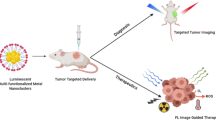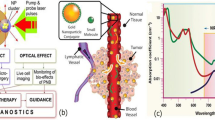ABSTRACT
Purpose
The purpose of the present study was to explore the utilization of cinnamon-coated gold nanoparticles (Cin-AuNPs) as CT/optical contrast-enhancement agents for detection of cancer cells.
Methods
Cin-AuNPs were synthesized by a “green” procedure, and the detailed characterization was performed by physico-chemical analysis. Cytotoxicity and cellular uptake studies were carried out in normal human fibroblast and cancerous (PC-3 and MCF-7) cells, respectively. The efficacy of detecting cancerous cells was monitored using a photoacoustic technique. In vivo biodistribution was studied after IV injection of Cin-AuNPs in mice, and also a CT phantom model was generated.
Results
Biocompatible Cin-AuNPs were synthesized with high purity. Significant uptake of these gold nanoparticles was observed in PC-3 and MCF-7 cells. Cin-AuNPs internalized in cancerous cells facilitated detectable photoacoustic signals. In vivo biodistribution in normal mice showed steady accumulation of gold nanoparticles in lungs and rapid clearance from blood. Quantitative analysis of CT values in phantom model revealed that the cinnamon-phytochemical-coated AuNPs have reasonable attenuation efficiency.
Conclusions
The results indicate that these non-toxic Cin-AuNPs can serve as excellent CT/ photoacoustic contrast-enhancement agents and may provide a novel approach toward tumor detection through nanopharmaceuticals.









Similar content being viewed by others
REFERENCES
Yang MD, Liu YK, Shen JL, Wu CH, Lin CA, Chang WH, et al. Improvement of conversion efficiency for multi-junction solar cells by incorporation of Au nanoclusters. Opt Express. 2008;16:15754–8.
Jain PK, Huang X, El-Sayed IH, El-Sayed MA. Noble metals on the nanoscale: optical and photothermal properties and some applications in imaging, sensing, biology, and medicine. Acc Chem Res. 2008;41:1578–86.
Murphy CJ, Gole AM, Stone JW, Sisco PN, Alkilany AM, Goldsmith EC, et al. Gold nanoparticles in biology: beyond toxicity to cellular imaging. Acc Chem Res. 2008;41:1721–30.
Wang Y, Mirkin CA, Park SJ. Nanofabrication beyond electronics. ACS Nano. 2009;3:1049–56.
Esumi K, Kameo A, Suzuki A, Torigoe K. Preparation of gold nanoparticles in formamide and N, N-dimethylformamide in the presence of poly(amidoamine) dendrimers with surface methyl ester groups. Colloids Surf, A Physicochem Eng Asp. 2001;189:155–61.
Feitz A, Guan J, Waite D. Process for producing a nanoscale zero-valent metal. US Patent Application Publication. US2006/0083924 A1 (2006).
Fent GM, Casteel SW, Kim DY, Kannan R, Katti K, Chanda N. Biodistribution of maltose and gum arabic hybrid gold nanoparticles after intravenous injection in juvenile swine. Nanomedicine:NBM. 2009;5:128–35.
Katti K, Chanda N, Shukla R, Zambre A, Suibramanian T, Kulkarni RR, et al. Nanotechnology from cumin phytochemicals: generation of biocompatible gold nanoparticles. International Journal of Nanotechnology: Biomedicine. 2009;1:B39–52.
Katti KK, Kattamuri V, Bhaskaran S, Kannan R, Katti KV. Facile and general method for synthesis of sugar-coated gold nanoparticles. International Journal of Nanotechnology: Biomedicine. 2009;1:B53–9.
Kattumuri V, Katti K, Bhaskaran S, Boote EJ, Casteel SW, Fent GM, et al. Gum arabic as a phytochemical construct for the stabilization of gold nanoparticles: in vivo pharmacokinetics and X-ray-contrast-imaging studies. Small. 2007;3:333–41.
Kattumuri V, Chandrasekhar M, Guha S, Kannan R, Katti KV, Ghosh TK, et al. Agarose-stabilized gold nanoparticles for surface-enhanced Raman spectroscopic detection of DNA nucleosides. Appl Phys Lett. 2006;88:153114.
Nune S, Chanda N, Shukla R, Katti K, Kulkarni RR, Thilakavathy S, et al. Green nanotechnology from tea: phytochemicals in tea as building blocks for production of biocompatible gold nanoparticles. J Mater Chem. 2009;19:2912–20.
Shukla R, Nune SK, Chanda N, Katti K, Mekapothula S, Kulkarni RR, et al. Soybeans as a phytochemical reservoir for the production and stabilization of biocompatible gold nanoparticles. Small. 2008;4:1425–36.
Shukla R, Nune SK, Chanda N, Katti K, Mekapothula S, Kulkarni RR, et al. Soybeans as a phytochemical reservoir for the production and stabilization of biocompatible gold nanoparticles. Science Editors’ Choice. 2008;322:167.
Hoyoku N, Yoshiko S, Harukuni T, Mitsuharu M. Cancer control by phytochemicals. Curr Pharm Des. 2007;13:3394–9.
Johnson IT. Phytochemicals and cancer. Proc Nutr Soc. 2007;66:207–15.
Dekker M, Verkrek R. Dealing with variability in food production chains: a tool to enhance the sensitivity of epidemiological studies on phytochemicals. Eur J Nutr. 2003;42:67–72.
Holst B, Williamson G. Nutrients and phytochemicals: from bioavailability to bioefficacy beyond antioxidants. Curr Opin Biotechnol. 2008;19:73–82.
Gow RT, Li D, Sypert GW, Alberte RS. Extracts and methods comprising cinnamon species. US Patent Application Publication US 2007/0292540 Al (2007).
Mathew S, Abraham TE. Studies on the antioxidant activities of cinnamon (Cinnamomum verum) bark extracts, through various in vitro models. Food Chem. 2006;94:520–8.
Lopez P, Sanchez C, Batlle R, Nerin C. Vapor-phase activities of cinnamon, thyme, and oregano essential oils and key constituents against foodborne microorganisms. J Agric Food Chem. 2007;55:4348–56.
Shan B, Cai YZ, Brooks JD, Corke H. Antibacterial properties and major bioactive components of cinnamon stick (Cinnamomum burmannii): activity against foodborne pathogenic bacteria. J Agric Food Chem. 2007;55:5484–90.
Shan B, Cai YZ, Sun M, Corke H. Antioxidant capacity of 26 spice extracts and characterization of their phenolic constituents. J Agric Food Chem. 2005;53:7749–59.
Usta J, Kreydiyyeh S, Barnabe P, Bou-Moughlabay Y, Nakkash-Chmaisse H. Comparative study on the effect of cinnamon and clove extracts and their main components on different types of ATPases. Hum Exp Toxicol. 2003;22:355–62.
Schmidt-Kloiber H, Paltauf G. Measuring optical tissue data using pulsed photoacoustic spectroscopy (PPAS). Biomed Tech (Berl). 1997;42(Suppl):227–8.
Faha OR. OSIRIX: An oepn source platform for advanced multimodality medical imaging. IEEE Information & Communications Technology (2006).
Chanda N, Shukla R, Katti KV, Kannan R. Gastrin releasing protein receptor—specific gold nanorods: breast and prostate tumor-avid nanovectors for molecular imaging. Nano Lett. 2009;9:1798–805.
Kannan R, Rahing V, Cutler C, Pandrapragada R, Katti KK, Kattumuri V, et al. Nanocompatible chemistry toward fabrication of target-specific gold nanoparticles. J Am Chem Soc. 2006;128:11342–3.
Kannan R, Cutler C, Rahing V, Smith C, Katti K. Bioconjugated radioactive gold nanoparticles and their in vivo targeting abilities in small animal models. J Nucl Med. 2006;510(Supplement 1):510.
Kannan R, Katti KV, Katti KK, White HW, Cutler CS. Methods and articles for gold nanoparticle production. US 2007/0051202 A1, US Patent Application Publication (2007).
Katti K, Kannan R, Katti KK, Bhaskaran S, Pandrapragada RK. Optimization and production of gold and silver nanoparticles for potential imaging applications. Molecular Imaging. 2004;3:278.
Chanda N, Kan P, Watkinson LD, Shukla R, Zambre A, Carmack TL, et al. Radioactive gold nanoparticles in cancer therapy: therapeutic efficacy studies of 198AuNP-GA nanoconstruct in prostate tumor bearing mice. Nanomedicine: NBM. 2009;6:201–9.
Chanda N, Kattumuri V, Shukla R, Zambre A, Katti K, Upendran A, et al. Bombesin functionalized gold nanoparticles show in vitro and in vivo cancer receptor specificity. Proc Natl Acad Sci USA. 2010;107:8760–5.
Na H-K, Surh YJ. Intracellular signaling network as a prime chemopreventive target of (-)-epigallocatechin gallate. Mol Nutr Food Res. 2006;50:152–9.
de Sun J, Liu Y, Lu DC, Kim W, Lee JH, Maynard J, et al. Endothelin-3 growth factor levels decreased in cervical cancer compared with normal cervical epithelial cells. Hum Pathol. 2007;38:1047–56.
Baratta MT, Dorman HJD, Deans SG, Figueiredo AC, Barroso JG, Ruberto G. Antimicrobial and antioxidant properties of some commercial essential oils. Flavour Fragr J. 1998;13:235–44.
Mallidi S, Joshi PP, Sokolov K, Emelianov S. On sensitivity of molecular specific photoacoustic imaging using plasmonic gold nanoparticles. Conf Proc IEEE Eng Med Biol Soc. 6338–6340 (2009).
Mallidi S, Larson T, Tam J, Joshi PP, Karpiouk A, Sokolov K, et al. Multiwavelength photoacoustic imaging and plasmon resonance coupling of gold nanoparticles for selective detection of cancer. Nano Lett. 2009;9:2825–31.
Pan D, Pramanik M, Senpan A, Ghosh S, Wickline SA, Wang LV, et al. Near infrared photoacoustic detection of sentinel lymph nodes with gold nanobeacons. Biomaterials. 2010;31:4088–93.
Pan D, Pramanik M, Senpan A, Yang X, Song KH, Scott MJ, et al. Molecular photoacoustic tomography with colloidal nanobeacons. Angew Chem Int Ed. 2009;48:4170–3.
Viator J, Gupta S, Goldschmidt BS, Bhattacharyya K, Kannan R, Shukla R, et al. Detection of gold nanoparticle enhanced prostate cancer cells using photoacoustic flowmetry with optical reflectance. Journal of Biomedical Nanotechnology. 2010;6:1–5.
Armstrong NR, Quinn RK, Vanderborgh NE. Voltammetry in sulfolane. Electrochemical behavior of benzaldehyde and substituted benzaldehydes. Anal Chem. 1974;46:1759–64.
Au L, Lu X, Xia Y. A comparative study of galvanic replacement reactions involving Ag Nanocubes and AuCl(2) or AuCl(4). Adv Mater Deerfield. 2008;20:2517–22.
Shaw IC. Gold-based therapeutic agents. Chem Rev. 1999;99:2589–600.
Gratton SE, Ropp PA, Pohlhaus PD, Luft JC, Madden VJ, Napier ME, et al. The effect of particle design on cellular internalization pathways. Proc Natl Acad Sci U S A. 2008;105:11613–8.
Hauck TS, Ghazani AA, Chan WC. Assessing the effect of surface chemistry on gold nanorod uptake, toxicity, and gene expression in mammalian cells. Small. 2008;4:153–9.
Galanzha EI, Shashkov EV, Spring PM, Suen JY, Zharov VP. In vivo, noninvasive, label-free detection and eradication of circulating metastatic melanoma cells using two-color photoacoustic flow cytometry with a diode laser. Cancer Res. 2009;69:7926–34.
Hickling TP, Clark H, Malhotra R, Sim RB. Collectins and their role in lung immunity. J Leukoc Biol. 2004;75:27–33.
ACKNOWLEDGEMENTS
This work has been supported by grants from the National Institutes of Health/National Cancer Institute under the Cancer Nanotechnology Platform program (grant number: 5R01CA119412-01), NIH-1R21CA128460-01; NIH-SBIR-Contract no. 241, NIH R21 CA 139186 -01, and University of Missouri-Research Board-Program C8761 RB 06-030 and Missouri Life Sciences Research Board. We thank Prof. Henry W. White (University of Missouri, Columbia, MO USA) for his valuable comments and corrections of this manuscript.
Author information
Authors and Affiliations
Corresponding author
Rights and permissions
About this article
Cite this article
Chanda, N., Shukla, R., Zambre, A. et al. An Effective Strategy for the Synthesis of Biocompatible Gold Nanoparticles Using Cinnamon Phytochemicals for Phantom CT Imaging and Photoacoustic Detection of Cancerous Cells. Pharm Res 28, 279–291 (2011). https://doi.org/10.1007/s11095-010-0276-6
Received:
Accepted:
Published:
Issue Date:
DOI: https://doi.org/10.1007/s11095-010-0276-6




